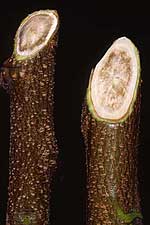Verticillium wilt of deciduous fruit trees
Verticillium wilt, also known as blackheart, is caused by the fungus Verticillium dahliae. The disease is found worldwide but is more serious in temperate areas.
Host plants
Verticillium wilt affects over 300 species, including both woody and herbaceous plants.
The disease can affect the following fruit trees:
- apricot (most commonly)
- nectarine
- peach
- plum.
Infections of apple and pear trees are rare.
The following nut trees are also susceptible:
- almond
- chestnut
- pistachio
- walnut.
Resistant plants include:
- all monocots (including cereals and grasses)
- all gymnosperms (conifers and relatives)
- some other plants, including apples, pears, oaks and willows.
Symptoms
The disease is usually observed in early summer as a progressive loss of leaves from infected limbs, starting at the base of each branch (Figure 1).

Leaves may become yellow and dull in appearance before dropping prematurely. By late summer, only a tuft of leaves may remain at the tip of a severely affected branch (Figure 2).

Occasionally leaves may show a true wilt, and when the death of these leaves is very rapid they may remain attached to the plant for several weeks. An entire tree can show these symptoms, or infection may be confined to one side, or even one branch, of the tree.
The most important diagnostic symptom of this disease is found when the trunk, branches or twigs are cut open to reveal the internal wood (Figure 3). Diseased wood shows in the cross section as a series of light to dark brown, irregularly shaped spots that sometimes merge into a ring of stained tissue. In mild cases of infection, wood staining may occur in the absence of any leaf symptoms.

Economic importance
The disease is serious for commercial growers because, though affected trees rarely die quickly, they may remain stunted and unproductive for many years. There is also a strong probability that replacement trees will be attacked in later seasons.
The fungus is widespread and particularly prevalent on land that has been repeatedly cropped with susceptible crops (alternative hosts for the fungus) such as:
- potatoes
- strawberries
- tomatoes.
Disease cycle
The fungus survives in the soil for many years as resting-bodies (micro-sclerotia) and as a root-parasite of many crop plants and weeds. Mycelium enters a healthy plant by penetrating the root hairs, or through any wound. The fungus then grows into the water-conducting wood, in which it forms spores.
These spores are carried upwards, with the flow of water, to the stem and leaves, giving rise to a continuous strand of infected wood from the invaded root to the branches and leaves vertically above it.
Controlling verticillium wilt
Verticillium wilt is difficult to control because the source of infection occurs in the soil and the fungus spreads internally throughout the tree. No method is available for treating infected orchard trees.
Reduce fungus in soil
To prevent Verticillium from attacking fruit trees, try to reduce the amount of fungus in the soil. You can do this in the following ways:
- Only plant new blocks of stone fruit on land that has been under grass for several years and avoid planting stone fruit into sites that have had a history of crops such as potatoes, tomatoes or strawberries.
- If fruit trees must be planted in soil known to be infested with Verticillium, then plant apples or pears, as these species show marked resistance to the disease. Apricots grown on plum rootstocks also show some resistance to the disease, and can be planted where other options are not available.
- Use only high-quality, disease-free planting material, because transmission of V. dahliae in vegetative planting stock is significant.
- Avoid intercropping blocks of young stone fruit with tomatoes, potatoes, peppers, strawberries or melons, as these susceptible crops can increase the population of Verticillium in the soil.
- Suppress weeds after planting or sow the block down to grass and clover to prevent a rapid increase of Verticillium in the soil. Important weed hosts of Verticillium belong to the families Chenopodiaceae (fat hen), Solanaceae (nightshade), and Amaranthaceae (red-root amaranthus).
- Remove seriously affected, unproductive trees and as much of their roots as possible. Fumigate or otherwise treat (for example, by soil solarisation) the area to kill any remaining fungus before replanting.
- Avoid subjecting young plants to water stress, root damage and excessive quantities of fertiliser.
Reporting an unusual plant insect pest or disease
Report any unusual plant pest or disease immediately using our online reporting form or by calling the Exotic Plant Pest Hotline on 1800 084 881. Early reporting increases the chance of effective control and eradication.
Please take multiple good quality photos of the pests or damage to include in your report where possible, as this is essential for rapid pest and disease diagnosis and response.
Your report will be responded to by an experienced staff member, who may seek more information about the detection and explain next steps.
Report online